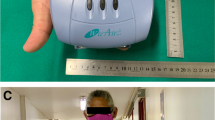Abstract
Purpose
The purpose of this study was to test the hypothesis that the surgical technique using alternating fluid irrigation and carbon dioxide (CO2) gas medium as a means of knee joint distension during arthroscopy is a safe and effective method, compared to traditional fluid arthroscopy.
Methods
This prospective randomized comparative study involved 94 patients undergoing the same arthroscopic ACL reconstruction surgical procedure except for the medium used to distend the joint: In a first group of 48 patients (“ACL gas” group), CO2 insufflation was mainly used, at a low pressure of 40–50 mmHg, alternating with a fluid medium for knee joint washout only. In the second group of 46 patients, classical arthroscopic joint distension by fluid was used, with a pump pressure of 50–70 mmHg. Early pre- and post-operative complications, duration of surgery, intraoperative monitoring data and particularly the end-tidal carbon dioxide (EtCO2) as a marker of CO2 blood diffusion were prospectively collected.
Results
EtCO2 and other monitoring data changes before and after tourniquet release were not different between the two groups. Tourniquet time was significantly longer when using fluid rather than gas. We observed 3 cases of small and localized subcutaneous emphysema, resolving completely within hours. Hematoma and reflex sympathetic dystrophy occurred more often in the “ACL fluid” group, with no statistical significance.
Conclusion
Low-pressure CO2 knee joint insufflation proved to be a safe technique capable of improving surgical comfort compared with the use of fluid alone. The CO2 blood diffusion measured by end-tidal carbon dioxide monitoring during ACL arthroscopic reconstruction was similar with or without gas insufflation.
Level of evidence
Randomized controlled trial, Level I.






Similar content being viewed by others
References
Bourne MH, Watson RC, Carmichael SW (1993) Pneumoperitoneum as a complication of carbon dioxide knee arthroscopy. A case report. Am J Sports Med 21(4):623–625
Couture P, Boudreault D, Derouin M, Allard M, Lepage Y, Girard D, Blaise G (1994) Venous carbon dioxide embolism in pigs: an evaluation of end-tidal carbon dioxide, transesophageal echocardiography, pulmonary artery pressure, and precordial auscultation as monitoring modalities. Anesth Analg 79:867–873
Descartes R (2001) Optics. In: Hackett Publishing (Ed) Discourse on method, geometry, and meteorology (trans: Paul Olscamp, Bobbs-Merill), Indianapolis, 1965; revised edn. Indianapolis, pp 65–176
Dickson M, White H, Kinney W, Kambam JR (1990) Extremity tourniquet deflation increases end-tidal PCO2. Anesth Analg 70:457–458
Eriksson E, Sebik A (1982) Arthroscopy and arthroscopic surgery in a gas versus a fluid medium. Orthop Clin North Am 13(2):293–298
Estebe JP, Mallédant Y (1996) Pneumatic tourniquets in orthopedics. Ann Fr Anesth Reanim 15:162–178
Girardis M, Milesi S, Donato S, Raffaelli M, Spasiano A, Antonutto G, Pasqualucci A, Pasetto A (2000) The hemodynamic and metabolic effects of tourniquet application during knee surgery. Anesth Analg 91:727–731
Henche HR (1980) Examination of the liquid- or gas-filled joint. In: Arthroscopy of the knee joint. Springer, Berlin, pp 13–17
Imbert P (2007) Minimally invasive extra-articular anterolateral reinforcement: a new technique. Arthroscopy 23:907.e1–907.e4
Jansson N (2005) Gas arthroscopy for removal of osteochondral fragments of the palmar/plantar aspect of the metacarpo/metatarsophalangeal joint in horses. Vet Surg 34(2):128–132
Johnson LL (1986) Arthroscopic surgery: principles and practice. Mosby, St.Louis
Lotman DB (1987) Pneumoperitoneum and acidosis during arthroscopy with CO2. Arthroscopy 3(3):185–186
Moon YL, Kim SJ (2004) Bursoscopic evaluation for degree of rotator cuff tear using an air-infusion method. Arthroscopy 20(8):e105–e107
Mullett CE, Viale JP, Sagnard PE, Miellet CC, Ruynat LG, Counioux HC, Motin JP, Boulez JP, Dargent DM, Annat GJ (1993) Pulmonary CO2 elimination during surgical procedures using intra- or extraperitoneal CO2 insufflation. Anesth Analg 76:622–626
Pandia MP, Bithal PK, Bali A, Soudagar A, Aggarwal AK (2003) Tourniquet release and end tidal CO2 changes—how long we need to be vigilant? Indian J Anaesth 47:134–136
Patel AJ, Choi CS, Giuffrida JG (1987) Changes in end tidal CO2 and arterial blood gas levels after release of tourniquet. South Med J 80:213–216
Perilli V, Vitale F, Modesti C, Ciocchetti P, Sacco T, Sollazzi L (2012) Carbon dioxide elimination pattern in morbidly obese patients undergoing laparoscopic surgery. Surg Obes Relat Dis 8(5):590–594
Riddell RR (1990) CO2 arthroscopy of the knee. Clin Orthop Relat Res 252:92–94
Schranz PJ, Farrington WJ (2003) Arthroscopic anterior cruciate ligament reconstruction: an air-fluid medium to enhance visual clarity. Arthroscopy 19(3):E22
Shupak RC, Shuster H, Funch RS (1984) Airway emergency in a patient during CO2 arthroscopy. Anesthesiology 60(2):171–172
Souders JE (2000) Pulmonary air embolism. J Clin Monit Comput 16:375–383
Strobel MJ (2002) Distension medium. In: Manual of arthroscopy surgery. Springer, Berlin, pp 52–53
Struhl S (1998) Dynamic assessment of shoulder and patellofemoral pathology using limited-volume gas arthroscopy. Arthroscopy 14(5):546–550
Tanaka T, Satoh K, Torii Y, Suzuki M, Furutani H, Harioka T (2006) Arterial to end-tidal carbon dioxide tension difference during laparoscopic colorectal surgery. Masui 55:988–991
Zaman SM, Islam MM, Chowdhury KK, Rickta D, Ireen ST, Choudhury MR, Alam M (2010) Haemodynamic and end tidal CO2 changes state after inflation and deflation of pneumatic tourniquet on extremities. Mymensingh Med J 19:524–528
Acknowledgments
The authors want to thanks Professor Mahmut Nedim Doral (ESSKA Scientific Committee) for encouragement and intellectual support.
Conflict of interest
The authors declare that they have no conflict of interest.
Author information
Authors and Affiliations
Corresponding author
Rights and permissions
About this article
Cite this article
Imbert, P., Schlatterer, B. A risk–benefit analysis of alternating low-pressure CO2 insufflation and fluid medium in arthroscopic knee ACL reconstruction. Knee Surg Sports Traumatol Arthrosc 22, 1483–1490 (2014). https://doi.org/10.1007/s00167-013-2474-3
Received:
Accepted:
Published:
Issue Date:
DOI: https://doi.org/10.1007/s00167-013-2474-3




